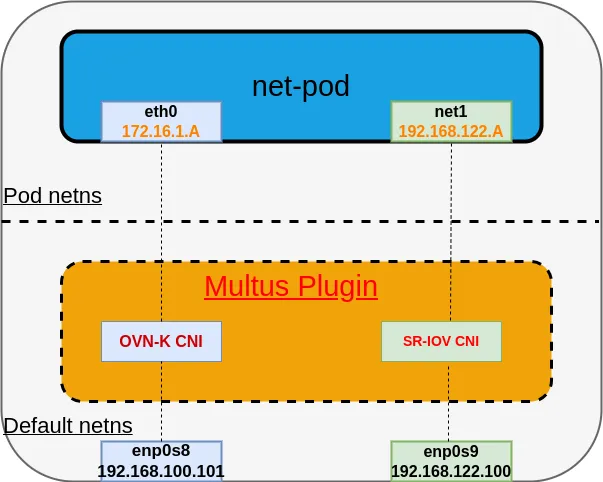Network Observability for secondary interfaces with Multus and SR-IOV plugins in Kubernetes can be a complex task, but it's crucial for monitoring and troubleshooting network issues in a Kubernetes cluster.
Overview of achieving network observability for a secondary interface

- Multus CNI plugin: Multus is a Container Network Interface (CNI) plugin for Kubernetes that allows you to attach multiple network interfaces to pods. In OpenShift, Multus is used to attach SR-IOV vfs to your pods. For reference and more details about Multus CNI, please refer to the Multus OCP documentation.
- SR-IOV plugin: SR-IOV (Single Root I/O Virtualization) is a technology that enables the partitioning of a single PCIe network adapter into multiple virtual functions (VFs). Pods can use these VFs as secondary network interfaces, achieving higher performance and isolation. For reference and more details about SR-IOV, refer to the SR-IOV OCP documentation.
Network Observability eBPF agent enhancements to support the secondary interface
To provide network observability for secondary interfaces in this setup and make the eBPF agent network namespace aware, eBPF agents need to implement the following steps:
- Using fsNotify package: Utilize the fsNotify package to be notified when new network namespaces are created. This allows the eBPF agent to keep track of network namespace creation events.
- Using netlink package: Employ the netlink package to register when the network interfaces are created or deleted within each network namespace. This will enable the eBPF agent to monitor the interface changes on a per-namespace basis.
- Attaching/detaching eBPF TC hooks: Add support to the eBPF agent to attach and detach the eBPF Traffic Control (TC) hook for network interfaces in non-default network namespaces. This step is crucial for monitoring and controlling network traffic within these network namespaces.
Configuring SR-IOV objects
- Install the SR-IOV operator in the environment.
- Identify the SR-IOV-capable device on the node.
- Label the node that has the SR-IOV interface with the feature.node.kubernetes.io/network-sriov.capable=true label.
- Create the SriovNetworkNodePolicy object.
apiVersion: sriovnetwork.openshift.io/v1
kind: SriovNetworkNodePolicy
metadata:
name: mypolicy
namespace: openshift-sriov-network-operator
spec:
resourceName: netdeviceresource
nodeSelector:
feature.node.kubernetes.io/network-sriov.capable: "true"
priority: 99
numVfs: 50
nicSelector:
pfNames: ["ens7f0np0#25-49"]
deviceType: netdevice
5. Create the SriovNetwork object. This will create net-attach-def in the openshift-sriov-network-operator namespace.
apiVersion: sriovnetwork.openshift.io/v1
kind: SriovNetwork
metadata:
name: sriov-test
namespace: openshift-sriov-network-operator
spec:
resourceName: netdeviceresource
networkNamespace: test
ipam: '{ "type": "static", "addresses": [{"address": "192.168.122.71/24"}]}'
6. Create a test pod using the SRIOVNetwork object created above and denoted by the k8s.v1.cni.cncf.io/networks: "sriov-test" annotation.
apiVersion: v1
kind: Pod
metadata:
name: httpd-2
namespace: openshift-sriov-network-operator
labels:
app: sriov
annotations:
k8s.v1.cni.cncf.io/networks: "sriov-test"
spec:
containers:
- name: httpd
command: ["sleep", "30d"]
image: registry.redhat.io/rhel8/support-tools
ports:
- containerPort: 8080
securityContext:
allowPrivilegeEscalation: false
seccompProfile:
type: RuntimeDefault
capabilities:
drop:
- ALL
Configuring the Network Observability operator to work with SR-IOV
- Deploy the Network Observability operator.
- Create the FollowCollector object with privileged set to true.
apiVersion: flows.netobserv.io/v1beta1
kind: FlowCollector
metadata:
name: cluster
spec:
agent:
type: EBPF
ebpf:
privileged: true
The Network Observability operator will deploy its components (eBPF agent, flowlogs pipeline, and console plugin). The eBPF agent will start discovering all the interfaces, attach the eBPF hooks, and then flows start being collected.
Sample Network Observability raw flow output by filtering on Pod VF interface net1
View Network Observability output by opening the console plugin, looking in the Traffic Flows table, and filtering by Network interface name == net1. For example, if you filter by TCP flow packets, you'll see results like the following:

Feedback
Netobserv is an open source project available on GitHub. Feel free to share your ideas, use cases, or ask the community for help.
Über den Autor
Ähnliche Einträge
Red Hat to acquire Chatterbox Labs: Frequently Asked Questions
Key considerations for 2026 planning: Insights from IDC
Edge computing covered and diced | Technically Speaking
Nach Thema durchsuchen
Automatisierung
Das Neueste zum Thema IT-Automatisierung für Technologien, Teams und Umgebungen
Künstliche Intelligenz
Erfahren Sie das Neueste von den Plattformen, die es Kunden ermöglichen, KI-Workloads beliebig auszuführen
Open Hybrid Cloud
Erfahren Sie, wie wir eine flexiblere Zukunft mit Hybrid Clouds schaffen.
Sicherheit
Erfahren Sie, wie wir Risiken in verschiedenen Umgebungen und Technologien reduzieren
Edge Computing
Erfahren Sie das Neueste von den Plattformen, die die Operations am Edge vereinfachen
Infrastruktur
Erfahren Sie das Neueste von der weltweit führenden Linux-Plattform für Unternehmen
Anwendungen
Entdecken Sie unsere Lösungen für komplexe Herausforderungen bei Anwendungen
Virtualisierung
Erfahren Sie das Neueste über die Virtualisierung von Workloads in Cloud- oder On-Premise-Umgebungen
